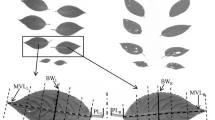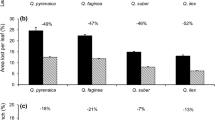Abstract
For the last 50 years, Chamois (Rupicapra rupicapra) population exponentially increased in the French Alps. This herbivore faces a food shortage in the winter; its diet mainly includes woody species (Abies alba Mill.) and brambles (Rubus fruticosus). The physiological response following simulated herbivory of these two plants was assessed. More precisely, the effects of leaf clipping and ungulate saliva application on the epidermal flavonoids and chlorophyll contents were considered as an induced structural response. The chlorophyll fluorescence (Fv/Fm) was also measured to provide information on the photosynthesis status as an induced functional response. The non-invasive techniques used in this experiment highlighted an induced response, emerging during the days following the simulated herbivory. R. fruticosus was drastically affected, photosynthesis was disturbed (decreased Fv/Fm) and mortality began on day 5 reaching 100 % less than 1 week later. Physiological parameters were also affected in A. alba (slight decrease of Fv/Fm and lower content of flavonoids), but this species recovered and survived no matter what the stressing treatment was. These results did not point out an efficient repulsive-induced response of A. alba and R. fruticosus to herbivory. The existence of constitutive defences such as prickles (R. fruticosus) or low-digestible tannins (A. alba) is no more efficient to escape from ungulates consumption. Nevertheless, in spite of the increase of the ungulates exponential demography, these two plants do not face rarefaction problem in the French Alps. Thus, survival of A. alba stands is probably linked to the recovery ability of saplings, when R. fruticosus stands maintain themselves thanks to the strong resprouting capacity of this species.





Similar content being viewed by others
References
Babad G (1997) Etude des relations entre un peuplement animal et la végétation : impacts du Chamois, du Chevreuil et du Mouflon sur les peuplements forestiers dans la réserve nationale de faune sauvage et de chasse des Bauges (Savoie). Université de Savoie, Chambéry
Bazely DR, Myers JH, Dasilva KB (1991) The response of numbers of bramble prickles to herbivory and depressed resource availability. Oikos 61(3):327–336. doi:10.2307/3545240
Bergman M (2002) Can saliva from moose, Alces alces, affect growth responses in the sallow, Salix caprea? Oikos 96(1):164–168. doi:10.1034/j.1600-0706.2002.960118.x
Bertolino S, di Montezemolo NC, Bassano B (2009) Food-niche relationships within a guild of alpine ungulates including an introduced species. J Zool 277(1):63–69. doi:10.1111/j.1469-7998.2008.00512.x
Bidel LPR, Meyer S, Goulas Y, Cadot Y, Cerovic ZG (2007) Responses of epidermal phenolic compounds to light acclimation: in vivo qualitative and quantitative assessment using chlorophyll fluorescence excitation spectra in leaves of three woody species. J Photochem Photobiol B 88(2–3):163–179. doi:10.1016/j.jphotobiol.2007.06.002
Boissier J-M (2005) Guide d’interprétation des habitats naturels du massif des Bauges. Conservatoire Botanique National Alpin
Buricova L, Andjelkovic M, Cermakova A, Reblova Z, Jurcek O, Kolehmainen E, Verhe R, Kvasnicka F (2011) Antioxidant capacity and antioxidants of strawberry, blackberry, and raspberry leaves. Czechoslov J Food Sci 29(2):181–189
Cartelat A, Cerovic ZG, Goulas Y, Meyer S, Lelarge C, Prioul JL, Barbottin A, Jeuffroy MH, Gate P, Agati G, Moya I (2005) Optically assessed contents of leaf polyphenolics and chlorophyll as indicators of nitrogen deficiency in wheat (Triticum aestivum L.). Field Crops Res 91(1):35–49. doi:10.1016/j.fcr.2004.05.002
Carter GA, Knapp AK (2001) Leaf optical properties in higher plants: linking spectral characteristics to stress and chlorophyll concentration. Am J Bot 88(4):677–684. doi:10.2307/2657068
Castro H, Nabais C, Alados CL, Freitas H (2003) Effects of cessation of grazing on leaf-level photosynthesis of Periploca laevigata. Appl Veg Sci 6(2):255–260. doi:10.1658/1402-2001(2003)006[0255:eocogo]2.0.co;2
Chaves MM, Flexas J, Pinheiro C (2009) Photosynthesis under drought and salt stress: regulation mechanisms from whole plant to cell. Ann Bot 103(4):551–560. doi:10.1093/aob/mcn125
Chen YE, Yuan S, Du JB, Xu MY, Zhang ZW, Lin HH (2009) Phosphorylation of photosynthetic antenna protein CP29 and photosystem II structure changes in monocotyledonous plants under environmental stresses. Biochemistry 48(41):9757–9763. doi:10.1021/bi901308x
Chiapusio G, Pellissier F (2001) Radiochemical techniques to quantify allelochemicals in plants. Handbook of plant ecophysiology techniques. Springer-Verlag, New York, pp 443–452
Chiapusio G, Pellissier F, Gallet C (2004) Uptake and translocation of phytochemical 2-benzoxazolinone (BOA) in radish seeds and seedlings. J Exp Bot 55(402):1587–1592
Corti R (2006) Inventaire des populations françaises d’ongulés de montagne. http://www.oncfs.gouv.fr/IMG/file/mammiferes/ongules/montagne/intro_conclusion_2006.pdf. Accessed 24 Nov 2012
Fornoni J (2011) Ecological and evolutionary implications of plant tolerance to herbivory. Funct Ecol 25(2):399–407. doi:10.1111/j.1365-2435.2010.01805.x
Gaillard JM, Loison A, Festa-Bianchet M, Yoccoz NG, Solberg E (2003) Ecological correlates of life span in populations of large herbivorous mammals. Popul Dev Rev 29:39–56
Galvez DA, Tyree MT (2009) Impact of simulated herbivory on water relations of aspen (Populus tremuloides) seedlings: the role of new tissue in the hydraulic conductivity recovery cycle. Oecologia 161(4):665–671. doi:10.1007/s00442-009-1416-8
Garrido E, Andraca-Gomez G, Fornoni J (2012) Local adaptation: simultaneously considering herbivores and their host plants. New Phytol 193(2):445–453. doi:10.1111/j.1469-8137.2011.03923.x
Goulas Y, Cerovic ZG, Cartelat A, Moya I (2004) Dualex: a new instrument for field measurements of epidermal ultraviolet absorbance by chlorophyll fluorescence. Appl Opt 43(23):4488–4496. doi:10.1364/ao.43.004488
Govindjee (1995) 63 years since Kautsky-chlorophyll-a fluorescence. Aust J Plant Physiol 22(2):131–160. doi:10.1071/pp9950131
Greenwood PL, Shutt DA (1992) Salivary and plasma-cortisol as an index of stress in goats. Aust Vet J 69(7):161–163. doi:10.1111/j.1751-0813.1992.tb07501.x
Gudej J, Tomczyk M (2004) Determination of flavonoids, tannins and ellagic acid in leaves from Rubus L. species. Arch Pharm Res 27(11):1114–1119. doi:10.1007/bf02975114
Gutbrodt B, Dorn S, Unsicker SB, Mody K (2012) Species-specific responses of herbivores to within-plant and environmentally mediated between-plant variability in plant chemistry. Chemoecology 22(2):101–111. doi:10.1007/s00049-012-0102-1
Häsler H, Senn J (2012) Ungulate browsing on European silver fir Abies alba: the role of occasions, food shortage and diet preferences. Wildl Biol 18(1):67–74. doi:10.2981/09-013
Häsler H, Senn J, Edwards PJ (2008) Light-dependent growth responses of young Abies alba to simulated ungulate browsing. Funct Ecol 22(1):48–57. doi:10.1111/j.1365-2435.2007.01346.x
Heil M (2010) Plastic defence expression in plants. Evol Ecol 24(3):555–569. doi:10.1007/s10682-009-9348-7
Hochwender CG, Marquis RJ, Stowe KA (2000) The potential for and constraints on the evolution of compensatory ability in Asclepias syriaca. Oecologia 122(3):361–370. doi:10.1007/s004420050042
Karban R (2011) The ecology and evolution of induced resistance against herbivores. Funct Ecol 25(2):339–347. doi:10.1111/j.1365-2435.2010.01789.x
Krause GH, Weis E (1991) Chlorophyll fluorescence and photosynthesis-the basics. Annu Rev Plant Physiol Plant Mol Biol 42:313–349. doi:10.1146/annurev.pp.42.060191.001525
Liu J, Wang L, Wang D, Bonser SP, Sun F, Zhou YF, Gao Y, Teng X (2012) Plants can benefit from herbivory: stimulatory effects of sheep saliva on growth of leymus chinensis. Plos One 7(1):e29259. doi:10.1371/journal.pone.0029259
Louis J, Meyer S, Maunoury-Danger F, Fresneau C, Meudec E, Cerovic ZG (2009) Seasonal changes in optically assessed epidermal phenolic compounds and chlorophyll contents in leaves of sessile oak (Quercus petraea): towards signatures of phenological stage. Funct Plant Biol 36(8):732–741. doi:10.1071/fp09010
Martemyanov VV, Dubovskiy IM, Rantala MJ, Salminen JP, Belousova IA, Pavlushin SV, Bakhvalov SA, Glupov VV (2012) The effects of defoliation-induced delayed changes in silver birch foliar chemistry on gypsy moth fitness, immune response, and resistance to baculovirus infection. J Chem Ecol 38(3):295–305. doi:10.1007/s10886-012-0090-1
Martz F, Jaakola L, Julkunen-Tiitto R, Stark S (2010) Phenolic composition and antioxidant capacity of bilberry (Vaccinium myrtillus) leaves in northern Europe following foliar development and along environmental gradients. J Chem Ecol 36(9):1017–1028. doi:10.1007/s10886-010-9836-9
Maschinski J, Whitham TG (1989) The continuum of plant-responses to herbivory-the influence of plant-association, nutrient availability, and timing. Am Nat 134(1):1–19. doi:10.1086/284962
Maxwell K, Johnson GN (2000) Chlorophyll fluorescence-a practical guide. J Exp Bot 51(345):659–668. doi:10.1093/jexbot/51.345.659
McEwen BS, Stellar E (1993) Stress and the individual-mechanisms leading to disease. Arch Intern Med 153(18):2093–2101. doi:10.1001/archinte.153.18.2093
MorenoCaselles J, PerezEspinosa A, PerezMurcia MD, Moral R, Gomez I (1997) Cobalt-induced stress in tomato plants: effect on yield, chlorophyll content, and nutrient evolution. J Plant Nutr 20(9):1231–1237. doi:10.1080/01904169709365330
Netto AT, Campostrini E, de Oliveira JG, Bressan-Smith RE (2005) Photosynthetic pigments, nitrogen, chlorophyll a fluorescence and SPAD-502 readings in coffee leaves. Sci Hortic 104(2):199–209. doi:10.1016/j.scienta.2004.08.013
O’Neill BF, Zangerl AR, Dermody O, Bilgin DD, Casteel CL, Zavala JA, DeLucia EH, Berenbaum MR (2010) Impact of elevated levels of atmospheric CO2 and herbivory on flavonoids of soybean (Glycine max Linnaeus). J Chem Ecol 36(1):35–45. doi:10.1007/s10886-009-9727-0
Pellissier F, Souto XC (1999) Allelopathy in northern temperate and boreal semi-natural woodland. Crit Rev Plant Sci 18(5):637–652
Perrin PM, Mitchell FJG, Kelly DL (2011) Long-term deer exclusion in yew-wood and oakwood habitats in southwest Ireland: changes in ground flora and species diversity. For Ecol Manage 262(12):2328–2337. doi:10.1016/j.foreco.2011.08.028
Petzold J, Brownie C, Gould F (2009) Effect of Heliothis subflexa herbivory on fruit abscission by Physalis species: the roles of mechanical damage and chemical factors. Ecol Entomol 34(5):603–613. doi:10.1111/j.1365-2311.2009.01109.x
Pieterse CMJ, Leon-Reyes A, Van der Ent S, Van Wees SCM (2009) Networking by small-molecule hormones in plant immunity. Nat Chem Biol 5(5):308–316. doi:10.1038/nchembio.164
Redjadj C (2010) Etude inter- et intra-spécifique des variations spatio-temporelles de l’utilisation des ressources alimentaires au sein d’une communauté de grands herbivores de montagne. PhD thesis, Université de Grenoble, Grenoble
Redondo-Gomez S, Mancilla-Leyton JM, Mateos-Naranjo E, Cambrolle J, Martin-Vicente A (2010) Differential photosynthetic performance of three Mediterranean shrubs under grazing by domestic goats. Photosynthetica 48(3):348–354. doi:10.1007/s11099-010-0045-0
Robakowski P, Wyka T, Samardakiewicz S, Kierzkowski D (2004) Growth, photosynthesis, and needle structure of silver fir (Abies alba Mill.) seedlings under different canopies. For Ecol Manage 201(2–3):211–227. doi:10.1016/j.foreco.2004.06.029
Rutigliano FA, DeSanto AV, Berg B, Alfani A, Fioretto A (1996) Lignin decomposition in decaying leaves of Fagus sylvatica L and needles of Abies alba Mill. Soil Biol Biochem 28(1):101–106. doi:10.1016/0038-0717(95)00120-4
Salaj J, Kormutak A (1995) Structural changes in mesophyll celles of Abies alba Mill. during the autumn–spring period. Biologia 50(1):93–98
Schales C, Gerlach H, Kosters J (1993) Investigations on the antibacterial effect of conifer needle oil on bateria isolated from the feces of captive capercaillies (Tetrao urogallus L., 1758). J Vet Med Ser B 40(6):381–390
Senn J, Suter W (2003) Ungulate browsing on silver fir (Abies alba) in the Swiss Alps: beliefs in search of supporting data. For Ecol Manage 181(1–2):151–164. doi:10.1016/s0378-1127(03)00129-4
Shemesh H, Ovadia O, Novoplansky A (2012) Prioritized contingencies: context-dependent regeneratory effects of grazer saliva. Plant Ecol 213(1):167–174. doi:10.1007/s11258-011-9968-1
Shimada T (2006) Salivary proteins as a defense against dietary tannins. J Chem Ecol 32(6):1149–1163. doi:10.1007/s10886-006-9077-0
Slimestad R (2003) Flavonoids in buds and young needles of Picea, Pinus and Abies. Biochem Syst Ecol 31(11):1247–1255. doi:10.1016/s0305-1978(03)00018-8
Stevens MT, Kruger EL, Lindroth RL (2008) Variation in tolerance to herbivory is mediated by differences in biomass allocation in aspen. Funct Ecol 22(1):40–47. doi:10.1111/j.1365-2435.2007.01356.x
Stolter C, Ball JP, Niemela P, Julkunen-Tiitto R (2010) Herbivores and variation in the composition of specific phenolics of boreal coniferous trees: a search for patterns. Chemoecology 20(4):229–242. doi:10.1007/s00049-010-0053-3
Stowe KA, Marquis RJ, Hochwender CG, Simms EL (2000) The evolutionary ecology of tolerance to consumer damage. Annu Rev Ecol Syst 31:565–595. doi:10.1146/annurev.ecolsys.31.1.565
Strauss SY, Rudgers JA, Lau JA, Irwin RE (2002) Direct and ecological costs of resistance to herbivory. Trends Ecol Evol 17(6):278–285. doi:10.1016/s0169-5347(02)02483-7
Thomson VP, Cunningham SA, Ball MC, Nicotra AB (2003) Compensation for herbivory by Cucumis sativus through increased photosynthetic capacity and efficiency. Oecologia 134(2):167–175. doi:10.1007/s00442-002-1102-6
Tyree MT, Sperry JS (1989) Vulnerability of xylem to cavitation and embolism. Annu Rev Plant Physiol Plant Mol Biol 40:19–38. doi:10.1146/annurev.pp.40.060189.000315
Valkama E, Koricheva J, Salminen JP, Helander M, Saloniemi I, Saikkonen K, Pihlaja K (2005) Leaf surface traits: overlooked determinants of birch resistance to herbivores and foliar micro-fungi? Trees-Struct Funct 19(2):191–197. doi:10.1007/s00468-004-0380-5
Vourc’h G, Martin JL, Duncan P, Escarre J, Clausen TP (2001) Defensive adaptations of Thuja plicata to ungulate browsing: a comparative study between mainland and island populations. Oecologia 126(1):84–93. doi:10.1007/s004420000491
Acknowledgments
The author is greatly indebted to Laurie Morales for her valuable help in PEA and Dualex measurements. Goat saliva was freely and abundantly provided by Maurice Michaud and sons, owners of the Grand-Champ goat farm (F-73170 Yenne). Thanks to Dr. Anne Loison (CNRS UMR 5553) and two anonymous reviewers for helpful comments concerning the manuscript and to Kate Desmurs whom corrected English.
Author information
Authors and Affiliations
Corresponding author
Rights and permissions
About this article
Cite this article
Pellissier, F. Early physiological responses of Abies alba and Rubus fruticosus to ungulate herbivory. Plant Ecol 214, 127–138 (2013). https://doi.org/10.1007/s11258-012-0151-0
Received:
Accepted:
Published:
Issue Date:
DOI: https://doi.org/10.1007/s11258-012-0151-0




